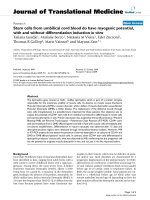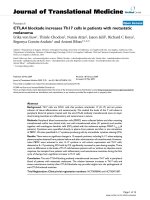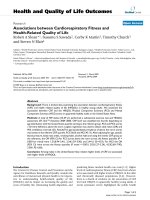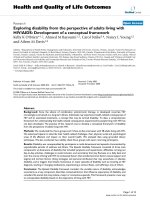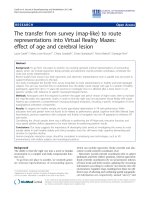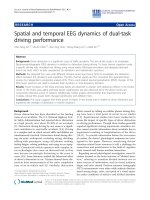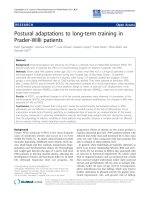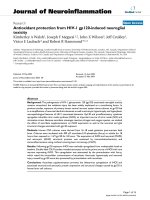Báo cáo hóa học: " Polymeric Nanocapsule from Silica Nanoparticle@Cross-linked Polymer Nanoparticles via One-Pot Approach" pdf
Bạn đang xem bản rút gọn của tài liệu. Xem và tải ngay bản đầy đủ của tài liệu tại đây (287.23 KB, 4 trang )
NANO EXPRESS
Polymeric Nanocapsule from Silica Nanoparticle@Cross-linked
Polymer Nanoparticles via One-Pot Approach
Ruoping Shen Æ Bin Mu Æ Pengcheng Du Æ
Peng Liu
Received: 6 June 2009 / Accepted: 3 July 2009 /Published online: 16 July 2009
Ó to the authors 2009
Abstract A facile strategy was developed here to prepare
cross-linked polymeric nanocapsules (CP nanocapsules)
with silica nanoparticles as templates. The silica nano-
particle@cross-linked polymer nanoparticles were prepared
by the encapsulation of the silica nanoparticles by the one-
pot approach via surface-initiated atom transfer radical
polymerization of hydroxyethyl acrylate in the presence of
N,N
0
-methylenebisacrylamide as a cross-linker from the
initiator-modified silica nanoparticles. After the silica
nanoparticle templates were etched with hydrofluoric acid,
the CP nanocapsules with particle size of about 100 nm were
obtained. The strategy developed was confirmed with Fou-
rier transform infrared, thermogravimetric analysis and
transmission electron microscopy.
Keywords Polymeric nanocapsule Á Cross-linked Á
Template Á One-pot Á SI-ATRP
Introduction
Polymer nanocapsules, the nanometer-sized hollow poly-
mer spheres, have attracted more and more researching
interests because of their fascinating potential applications
such as drug delivery [1, 2], microreactors [3, 4], imaging
[5], catalysts [6], and self-healing materials [7].
By now, many excellent strategies had been developed
for the preparation of polymer nanocapsules [8–10]. In
order to assert the control over the shell thickness of
polymeric nanocapsules, the approach based on the sur-
face-initiated controlled/‘‘living’’ radical polymerization
(CLRP) has been developed with nanoparticles as tem-
plates [11–15]. In the approach, the polymer brushes were
grafted from the nanoparticle templates via the surface-
initiated CLRP technique, and their functional side-groups
were cross-linked to obtain the cross-linked polymeric
shells. Then the structure-stable micro or nanocapsules
were achieved after the etching of the templates encapsu-
lated in the cross-linked polymeric shells.
In the present work, we developed a simple strategy for
the preparation of the cross-linked polymeric nanocapsules
(Scheme 1). The cross-linked polymeric shell was coated
on the silica nanoparticle templates via the surface-initiated
atom transfer radical polymerization (SI-ATRP) of
hydroxyethyl acrylate (HEA) in the presence of N,N
0
-
methylenebisacrylamide (MBA) as a cross-linker using a
one-pot method. So the cross-linking process of the poly-
mer brushes was not needed.
Experimental Section
Materials and Reagents
Silica nanoparticles with average particle size of 10 nm
were MN1P obtained from Zhoushan Mingri Nano-mate-
rials Co. Ltd, Zhejiang, China. They were dried in vacuum
at 110 °C for 48 h before use.
c-Aminopropyltriethoxysilane (APTES) (Gaizhou Chem-
ical Industrial Co. Ltd, Liaoning, China) was used as
received. Bromoacetylbromide was of analytical reagent
grade and purchased from Acros Organics (Phillipsburg,
New Jersey, USA). Cu(I)Br (Tianjin Chemical Co.,
R. Shen Á B. Mu Á P. Du Á P. Liu (&)
State Key Laboratory of Applied Organic Chemistry and
Institute of Polymer Science and Engineering, College of
Chemistry and Chemical Engineering, Lanzhou University,
730000 Lanzhou, People’s Republic of China
e-mail:
123
Nanoscale Res Lett (2009) 4:1271–1274
DOI 10.1007/s11671-009-9392-9
Tianjin, China) was of analytical reagent grade and purified
by being stirred in glacial acetic acid, filtered, washed with
ethanol and dried. 2,2
0
-Bipyridine (bpy) (A.R., 97.0%),
provided by Tianjin Chemical Co., China, was recrystal-
lized twice from acetone. HEA was of analytical reagent
grade from Beijing Eastern Yakeli Chemical Engineerings
S & T Ltd Co., Beijing, China.
Other reagents and solvents used were all of analytical
reagent grade and obtained from Tianjin Chemical Co.,
Tianjin, China, and were used without further purification.
Distilled water was used throughout.
Silica Nanoparticle@Cross-linked Polymer
(SN@CP) Nanoparticles
The initiator-modified silica nanoparticles, bromoacetyl-
modified silica nanoparticles (BrA-SN), were prepared
with the same procedures as reported previously [14].
The one-pot SI-ATRP of the monomer and cross-linker
from the initiator-modified silica nanoparticles was con-
ducted as follows [16]: the initiator-modified silica nano-
particles (SiO
x
–Br, 0.50 g, 0.25 mmol), 2, 2
0
-bipyridine
(bpy, 1.964 g, 12.576 mmol), and 50 mL water were
combined into a 100-mL round-bottom flask. After the
solution became homogeneous, the monomer, HEA
(15.7 mL, 150 mmol), and the cross-linker, MBA (2.313 g,
15 mmol), were added. The flask was sealed and deoxy-
genated by three freeze–pump–thaw cycles. During the
final cycle, the flask was filled with nitrogen, and 0.902 g
(6.288 mmol) of CuBr was added to the frozen mixture.
The flask was sealed with a glass stopper, then evacuated
and back-filled with nitrogen four times before it was
immersed in a thermostated oil bath at 70 °C. The poly-
merization was stopped at 72 h by opening the flask and
exposing the catalyst to air. The nanoparticles were washed
thoroughly with water and ethanol in turn and then dried in
vacuum.
Cross-linked Polymeric Nanocapsules
Part of the silica nanoparticles@cross-linked polymer
(SN@CP) nanoparticles was dispersed in aqueous solution
of hydrofluoric acid for 48 h to etch the silica nanoparticles
templates. The cross-linked polymeric nanocapsules were
separated by being centrifugated, washed with ethanol, and
dried in vacuum.
Analysis and Characterization
Bruker IFS 66 v/s infrared spectrometer was used for the
Fourier transform–infrared (FT–IR) spectroscopy analysis
in the range of 400–4,000 cm
-1
with the resolution of
4cm
-1
. The KBr pellet technique was adopted to prepare
the sample for recording the IR spectra. Thermogravimetric
analysis (TGA) was performed with a Perkin–Elmer TGA-
7 system at a scan rate of 20 °C min
-1
to 800 °CinN
2
atmosphere. The morphologies of the SN@CP particles
and the CP nanocapsules were characterized by a JEM-
1200 EX/S transmission electron microscope (TEM). The
nanocapsules were dispersed in water or dimethylform-
amide (DMF) in an ultrasonic bath for 5 min and then
deposited on a copper grid covered with a perforated car-
bon film.
Results and Discussion
The reaction scheme to the cross-linked polymeric nano-
capsules from the silica nanoparticles@cross-linked poly-
mer composite particles via the one-pot SI-ATRP technique
is illustrated in Scheme 1. In the first step, the terminal –OH
groups on the surface of silica nanoparticles were converted
to –NH
2
groups by the self-assembly of c-aminopropyl-
triethoxysilane on the surface of the silica nanoparticles.
4000 3500 3000 2500 2000 1500 1000 500
0
20
40
60
80
100
120
CP Nanocapsules
SN@CP
Transmittance (%)
Wavenumber (cm
-1
)
Fig. 1 FT–IR spectra of the SN@CP and CP nanocapsules
APTES
OH
O - Si - (CH
2
)
3
- NH
2
O - Si - (CH
2
)
3
- NH - C - CH
2
Br
O
SN
BrA-SN
Bromoacetylbromide
TEA
Br
( )
HF
water
Br
one-pot SI-ATRP
HEA, MBA
SN@CP
CP nanocapsule
Scheme 1 Reaction scheme for the cross-linked polymeric nano-
capsules
1272 Nanoscale Res Lett (2009) 4:1271–1274
123
Then the –NH
2
groups were bromoacetylated with bro-
moacetylbromide. The carbon and nitrogen elemental
analysis indicated that about 0.5 mmol initiating group per
one gram of SiO
x
–Br nanoparticles were immobilized [14].
After the one-pot radical copolymerization of monomer
HEA and cross-linker MBA via SI-ATRP technique, the
characteristic absorbances of the ester carbonyl and amide
carbonyl groups at 1,735 and 1,654 cm
-1
respectively, and
–OH stretching peak at 3,441 cm
-1
emerged in the FT–IR
spectrum of the SN@CP particles (Fig. 1). It indicated
that the monomer HEA and cross-linker MBA had
copolymerized from the initiator-modified silica nanopar-
ticles to form the cross-linked polymer shell.
The TGA curve of the SN@CP particles is shown in
Fig. 2. The cross-linked polymer shells were found to be
decomposed at the temperature higher than 350 °C. The
weight loss before the decomposition was attributed to the
release of the moisture adsorbed because the (co)polymers
of HEA and/or MBA have good water absorption. Thus,
the total percentage of grafting (mass ratio of the polymer
grafted and the silica template) was calculated to be about
12% with a polymerizing time of 72 h. It seemed that the
polymerizing rate in this work was lower than that of the
works reported [17, 18]. It might be due to the gelation of
the polymerization and the poor solubility of the polymer
shells in water [18].
Then the silica nanoparticle templates encapsulated
with the cross-linked polymer shells were removed by
being etched with hydrofluoric acid for 48 h. The prod-
ucts were also characterized with FT–IR, TGA, and TEM.
In the FT–IR spectrum of the CP nanocapsules (Fig. 1),
the peak at 1,099 cm
-1
and a middle peak at 804 cm
-1
corresponding to the symmetrical and asymmetrical
stretching vibration of Si–O–Si and the bend-vibration
absorption band of Si–O at 467 cm
-1
, which presented in
the FT–IR spectrum of the SN@CP particles, disappeared.
It indicated that the silica templates had been removed
completely by being etching with hydrofluoric acid for
48 h. The TGA curve of the CP nanocapsules (Fig. 2)
also testified the viewpoint because the sample had been
decomposed absolutely before 650 °C.
100 200 300 400 500 600 700 800
0
20
40
60
80
100
SN@CP
CP Nanocapsules
Weight (%)
Temperature (deg)
Fig. 2 TGA curves of the SN@CP and CP nanocapsules
Fig. 3 TEM images of the CP nanocapsules in water (a) and DMF (b)
Nanoscale Res Lett (2009) 4:1271–1274 1273
123
The TEM images of the CP nanocapsules are given in
Fig. 3. For the sample dispersed in water (Fig. 3a), the
obvious aggregation of the nanocapsules was found. As for
the sample dispersed in DMF, the single CP nanocapsules
were obtained (Fig. 3b). It also indicated that the cross-
linked polymer shells showed poor affinity with water.
The diameter (about 100 nm) of the CP nanocapsules
was found to be much bigger than that of the silica nano-
particle templates with an average diameter of 10 nm. It
was due to the aggregation of the silica nanoparticles in the
storage period and also the surface modification and cross-
linking polymerization processes, as reported previously
[14, 15, 17]. The aggregations in these works could be
broken partly with ultrasonic irradiation because the
polymer brushes grafted were not crosslinked. Contrarily,
the cross-linked polymer shells were obtained in the pres-
ent one-pot method. The interparticle aggregations here
could not be broken, so the cross-linked polymer shells
with the bigger size remained as the cross-linked polymeric
nanocapsules after the etching of the silica nanoparticle
templates.
Conclusions
In summary, cross-linked polymeric nanocapsules with
particle diameter of 100 nm were successfully prepared via
template approach with the one-pot surface-initiated atom
transfer radical cross-linking polymerization technique. So
the cross-linking reaction of the polymer brushes grafted
onto the templates could be ignored. Furthermore, the
synthetic method developed here is a generalized method,
which can be extended to the other cross-linked polymeric
nanocapsules. It is also expected that the cross-linking
degree of the polymeric shells could be controlled by the
polymerizing condition such as the molecular ratio of the
monomer and cross-linker.
Acknowledgments This project was granted financial support from
China Postdoctoral Science Foundation (Grant No. 20070420756) and
supported by the National Science Foundation for Fostering Talents in
Basic Research of the National Natural Science Foundation of China
(Grant No. J0730425).
References
1. J. Whelan, F. Writer, Drug Discov. Today 6, 1183 (2001)
2. K. Sablon, Nanoscale Res. Lett. 3, 265 (2008)
3. D.G. Shchukin, G.B. Sukhorukov, Adv. Mater. 16, 671 (2004)
4. C.S. Peyratout, L. Dahne, Angew. Chem. Inter. Ed. 43, 3762
(2004)
5. E. Pisani, N. Tsapis, B. Galaz, M. Santin, R. Berti, N. Taulier, E.
Kurtisovsmi, O. Lucidarme, M. Ourevitch, B.T. Doan, J.C.
Beloeil, B. Gillet, W. Urbach, S.L. Bridal, E. Fattal, Adv. Funct.
Mater. 18, 2963 (2008)
6. G.E. Lawson, Y. Lee, F.M. Raushel, A. Singh, Adv. Funct.
Mater. 15, 267 (2005)
7. B.J. Blaiszik, N.R. Sottos, S.R. White, Compos. Sci. Technol. 68,
978 (2008)
8. W. Meier, Chem. Soc. Rev. 29, 295 (2000)
9. P. Liu, J. Tian, W.M. Liu, Q.J. Xue, Prog. Chem. 16, 15 (2004)
10. G. Sukhorukov, A. Fery, H. Mohwald, Prog. Polym. Sci. 30, 885
(2005)
11. S. Blomberg, S. Ostberg, E. Harth, A.W. Bosman, B. van Horn,
C.J. Hawker, J. Polym. Sci.: Polym. Chem. 40, 1309 (2002)
12. G.D. Fu, Z. Shang, L. Hong, E.T. Kang, K.G. Neoh, Macro-
molecules 38, 7867 (2005)
13. T. Morinaga, M. Ohkura, K. Ohno, Y. Tsujii, T. Fukuda, Mac-
romolecules 40, 1159 (2007)
14. B. Mu, R.P. Shen, P. Liu, J. Nanosci. Nanotechnol. 9, 484 (2009)
15. B. Mu, R.P. Shen, P. Liu, Nanoscale Res. Lett. 4, 773 (2009)
16. H. Dong, M. Zhu, J.A. Yoon, H. Gao, R. Jin, K. Matyjaszewski,
J. Am. Chem. Soc. 130, 12852 (2008)
17. P. Liu, T.M. Wang, Curr. Appl. Phys. 8, 66 (2008)
18. E. Vargun, A. Usanmaz, J. Polym. Sci.: Polym. Chem. 43, 3957
(2005)
1274 Nanoscale Res Lett (2009) 4:1271–1274
123
